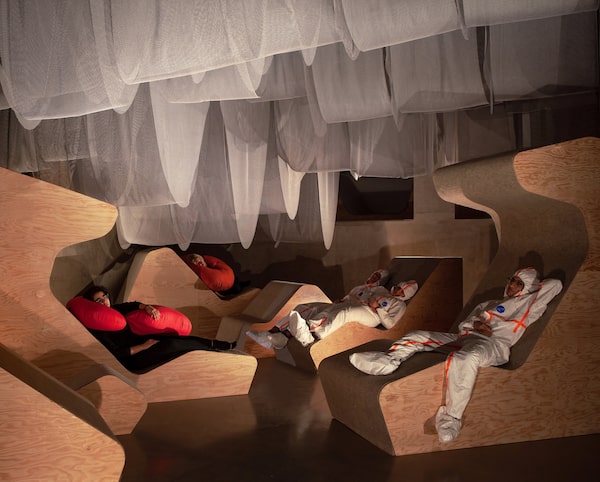As the lights come down, I settle down with a cushion into my felt-lined seat. A deep bass hum rolls through my lower body, and a high hum ripples across the textile walls around me. This space, a basement gallery, is rich in sound and texture. But it’s too dim to take a good picture. And the cell service is terrible.
Which is kind of the point. I’m sitting inside New Circadia (adventures in mental spelunking), an exhibition at the University of Toronto’s Daniels Faculty of Architecture, Landscape and Design. “We wanted to create a space for mind-wandering and distraction,” said Richard Sommer, the show’s co-curator, his voice rumbling through the dimness.
The show – which opened on Thursday and runs to April 30 – inaugurates the school’s new 7,500-square-foot Architecture and Design Gallery. Its title riffs on the Latin word that describes a daily cycle, as in “circadian rhythm." The theory behind the show is that we have become detached from such cycles and need to design a space in our lives for rest.

The New Circadia installation marks the opening of the Architecture and Design Gallery at the University of Toronto's Daniels Faculty of Architecture, Landscape and Design.Scott Norsworthy
Architecture has been deeply connected to “the shaping of space and time” that came with urbanization and the Industrial Revolution,” Sommer suggests. “It should be involved in the process of reckoning with that, perhaps rolling it back.”
On entering the gallery, I’d read descriptive texts and diagrams that explained the 24-hour cycles of people in different walks of life: a boarding-school student, an agricultural labourer, a service-industry worker.
This graphic and verbal treatment is more typical of architecture shows, “which situate a set of questions through which to understand architecture,” Sommer explains. “They require a lot of reading. And we didn’t want to do that entirely.”
I passed down into a basement space lined with plywood cabinetry and billowing volumes of grey felt. I chose my cushion from a rack of large and oddly shaped volumes in red, purple and yellow – designed by the show’s co-curators, Natalie Fizer and Emily Stevenson of the project Pillow Culture. Mine was red and roughly U-shaped, a vaguely biomorphic thing that felt cozy tucked around my neck.
“Cozy” is not what you would expect from an architecture exhibition. The medium either involves a representation of buildings and spaces on the one hand, or text-heavy conceptual presentations on the other. But this new space, in the basement of the Toronto faculty’s downtown building, allows different sorts of exploration. Its next exhibition, in the summer of 2020, will examine the way Toronto is growing and should grow, an issue of deep consequence and the kind of theme that an architecture school should attend to.
Meanwhile, a place to step away from all that. New Circadia does include some intellectual food for thought, with texts about the nature of sleep and how we perceive time, but these are easy to skip if you’d prefer to head for the warm embrace of cushions and felt.
“We want to create a space that people will want to hang out in and that will hopefully have an effect on their consciousness,” Sommer says. “And you can’t have it unless you’re in here.”
Editor’s note: A recent piece on the University of Toronto's Architecture and Design Gallery gave an incorrect figure for the gallery's size. It is 7,500 square feet, not 30,000 square feet.
New Circadia runs through April 30 at the Architecture and Design Gallery, 1 Spadina Cres., Toronto.
 Alex Bozikovic
Alex Bozikovic